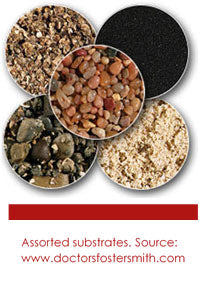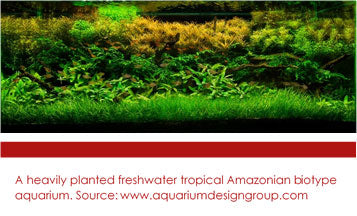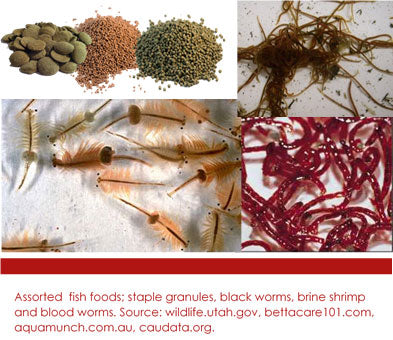Housing, Husbandry and Health of Ornamental Aquarium Fish
Michael A Grima, B.Sc.Hons I, GradCertVetStud, B.Vet.Bio/DVM*
*Faculty of Veterinary Science, School of Biological Sciences, The University of Sydney, Camperdown, Sydney, NSW.
Housing
Aquascaping of an aquarium prior to the introduction of fish and/or other aquatic invertebrates is key to successful fish keeping. Replicating the natural habitat of specific species in a captive environment is called biotyping. Captive aquatic environments like their natural counterparts usually possess the following key features;
-
Substrate – is a dominant feature of most aquariums and may be in the form of; gravel, aquasoil
 or sand. Substrate is; necessary for providing increased surface area for nitrifying bacterial populations for efficient breakdown of waste products, important for the stimulation, stabilisation and growth of aquatic plants and necessary for providing a habitat for many bottom dwelling fish and invertebrate species. The selection of the correct substrate for the various species of plants and animals housed is an important factor in biotype aquarium design. The particle size, colour, texture, depth, cleaning and in some cases periodic replacement of the substrate in an aquarium are important factors to consider when selecting the type of substrate for a particular biotype aquarium.
or sand. Substrate is; necessary for providing increased surface area for nitrifying bacterial populations for efficient breakdown of waste products, important for the stimulation, stabilisation and growth of aquatic plants and necessary for providing a habitat for many bottom dwelling fish and invertebrate species. The selection of the correct substrate for the various species of plants and animals housed is an important factor in biotype aquarium design. The particle size, colour, texture, depth, cleaning and in some cases periodic replacement of the substrate in an aquarium are important factors to consider when selecting the type of substrate for a particular biotype aquarium.
-
Rocks and Wood – provide habitat to many aquatic species. In an aquarium, rocks and wood are important as they; provide a refuge, breeding medium and increase the surface area of the entire system for nitrifying bacteria. Furthermore, in the community aquarium, where many species of fish and/or invertebrates cohabitate, the provision of such structures facilitates the establishment of territory, reduces aggression and provides refuge for small prey fish and invertebrates. Moreover, depending on the biotype, some rocks are essential in the setup they may slowly leach minerals and other substances into the water which changes the osmotic balance and pH of the system essentially mimicking natural environments e.g. in an African Cichlid Rift Lake biotype aquarium, the use of calcium carbonate based rocks ensures a stable alkaline buffered pH, which mimics the rift lakes of Africa; Malawi, Victoria and Tanganyika.

- Vegetation – the density and types of plant species in an aquarium provide a number of benefits to the system as a whole, they;
- Oxygenate the water by producing oxygen as a byproduct of photosynthesis.
- Absorb accumulating nitrogenous wastes like ammonia and nitrates.
- Provide refuge habitat and act as a breeding medium for many species of fish.
- Introduce new strains of beneficial nitrifying bacteria.

Steps in Setting Up a Freshwater Aquarium
- Wash substrate, ornaments, filters and aquarium prior to setting up the aquarium.
- Pour substrate into the bottom of the aquarium, and arrange any ornaments as desired.
- Fill the aquarium with water and add a water conditioner (ensures chlorine, chloramines and heavy metals are removed from tap water).
- Set up filters, heaters, air pumps and lights and turn them on.
- Set heater to desired temperature depending on the intended species (Table 1).
- Plants may now be planted in the aquarium substrate.
- Add a bacterial supplement (contains nitrifying bacterial cultures) which ensures the establishment of biological filtration in the aquarium (important for detoxification of organic waste as it is produced by fish, invertebrates, excess food and decaying plants).
- Test pH to ensure it is at an optimal level for the plants and eventual fish and invertebrate species (Table 1).
- Allow aquarium to settle for a week prior to introducing a few hardy fish. During this period, water should be tested for nitrogen waste compounds; ammonia, nitrite and nitrate to determine the stage of maturity of the system. A couple of extra doses of bacterial supplement should be added to provide enough bacteria which establish to facilitate waste breakdown.
- Once the nitrogen cycle is fully established (ammonia and nitrite levels are consistently 0 and there is a slight reaction of nitrate), which usually takes around 3 weeks, the aquarium is ready to be gradually stocked with fish and invertebrates.
Husbandry
- Water quality – the maintenance of a high level of water quality is achieved by;
- Periodic water chemistry testing for pH, salinity, chlorine, alkalinity/hardness, dissolved oxygen, ammonia, nitrite, nitrate and phosphate (Table 1).
- Monitoring and maintenance of consistent temperature – check functionality of heater by using a thermometer.
- Performing regular water changes using a gravel siphon.
|
Community/Biotype |
Temperature (ºC) |
pH |
General Hardness (ppm) |
|
|
TROPICAL – Warm Water |
|
|
|
General/Mixed |
23 – 27 |
6.8 – 7.2 |
50 – 150 |
|
Amazonian |
23 – 27 |
6.5 – 7 |
0 – 50 |
|
African Cichlid:
|
25 – 28 |
M: 7.5 – 8.5 V: 7.5 – 8.5 T: 7.5 – 9 |
200 – 400 |
|
American Cichlid |
24 – 28 |
7 – 8.5 |
50 – 100 |
|
Australian Native |
22 – 25 |
7 – 8.5 |
100 – 400 |
|
|
TEMPERATE – Cool Water |
|
|
|
Goldfish and Koi |
20 – 22 |
7.2 – 7.5 |
50 – 150 |
|
Australian Native |
15 – 23 |
7 – 8.5 |
100 – 400 |
|
Parameters may vary for individual fish species. Therefore, the table is intended as a generalised guide to fish tolerance ranges. |
|||

-
Feeding – fish should be fed once/day at any time and as a general guide only as much as they
 will eat in 30 seconds. Any excess uneaten food should be siphoned out to reduce waste buildup in the system. A staple granulated or flake food should be offered daily, however frozen foods including; brine shrimp and blood worms should replace staple food once or twice/week and an occasional treat of live black worms once every fortnight will ensure fish vitality.
will eat in 30 seconds. Any excess uneaten food should be siphoned out to reduce waste buildup in the system. A staple granulated or flake food should be offered daily, however frozen foods including; brine shrimp and blood worms should replace staple food once or twice/week and an occasional treat of live black worms once every fortnight will ensure fish vitality.
- Algae prevention and cleaning – nuisance alage accumulates quite readily on the glass and ornaments of aquariums. The growth of algae occurs due to a buildup of dissolved organic wastes in the form of phosphates and nitrates and as a result of excess light provided to the aquarium on a daily basis. There are many tropical fish species which can help to control algal blooms e.g. Bristlenose Catfish, True Siamensis/Flying Fox Algae Eaters, Borneo Suckers and Ottocinclus Catfish, however they only control but not erradicate the source of the problem. Nitrates and phosphates can be removed from the aquarium by performing water changes which essentially dilutes these waste products thereby decreasing the algae’s nutrient sources. Reducing the intensity and duration of the light provided to the tank also slows algal growth. Having a heavily planted aquarium is beneficial to control algae as plants outcompete the algae for nutrient souces. Even if all of these measures are taken to reduce algae buildup in the aquarium it may still be necessary to perform periodic manual removal by scrubbing glass and ornaments using filter wool (soft and un-abrasive) or a magnetic alge glass cleaner.
- Water changing and gravel cleaning/siphoning – 25 – 30% of aquarium water should be removed and replaced fortnightly to ensure consistent water quality. This is achieved by the use of a gravel siphon which not only removes water but at the same time cleans gravel of detritus (decaying organic material) which accumulates. New aquarium water is to be pre-treated with water conditioner, salt (if necessary for the particular species kept) and pH checked prior to its addition to the aquarium to ensure consistent water chemistry. Once the new water is introduced, a dose of bacterial supplement should be added to the aquarium in order to replenish potentially lost bacteria during the water change process.
- Filter cleaning and maintenance – occurs monthly and involves the scrubbing and rinsing of filter compartments including intake pipes, impellar and shaft and media containers. Mechanical filter media, that is, sponges that trap debris should either be replaced (in the case of filter wool) of rinsed. Biological filter media should also be thoroughly rinced, however not with tap water as it contains chlorine, chloramines and heavy metals that will kill the beneficial bacteria. It is a good idea to keep a bucket of old aquarium water aside from the previous weeks water change and use this when cleaning filter media to ensure, bacteria are not killed. Following filter cleaning, dosing the tank with bacterial supplement ensures that any bacteria lost in the cleaning process is replaced.
Health
- Prevention and treatment of disease – prevention of disease by natural or synthetic means in an aquarium is the best way to avoid potential outbreaks. In a freshwater system, many parasitic diseases and some fungal diseases are prevented by the addition of aquarium salt (sodium chloride 99%w/w). When a disease outbreak occurs, knowledge of the causative agent is critical when choosing the most appropriate treatment/medication. Another consideration is whether the chosen treatment/medication is safe for fish, nitrifying bacteria and invertebrates and if so what dosage will achieve the desired result and if post treatment measures need to be taken to maintain consistent water quality and general health of the beneficial nitrifying bacterial population.

 or sand. Substrate is; necessary for providing increased surface area for nitrifying bacterial populations for efficient breakdown of waste products, important for the stimulation, stabilisation and growth of aquatic plants and necessary for providing a habitat for many bottom dwelling fish and invertebrate species. The selection of the correct substrate for the various species of plants and animals housed is an important factor in biotype aquarium design. The particle size, colour, texture, depth, cleaning and in some cases periodic replacement of the substrate in an aquarium are important factors to consider when selecting the type of substrate for a particular biotype aquarium.
or sand. Substrate is; necessary for providing increased surface area for nitrifying bacterial populations for efficient breakdown of waste products, important for the stimulation, stabilisation and growth of aquatic plants and necessary for providing a habitat for many bottom dwelling fish and invertebrate species. The selection of the correct substrate for the various species of plants and animals housed is an important factor in biotype aquarium design. The particle size, colour, texture, depth, cleaning and in some cases periodic replacement of the substrate in an aquarium are important factors to consider when selecting the type of substrate for a particular biotype aquarium.
 will eat in 30 seconds. Any excess uneaten food should be siphoned out to reduce waste buildup in the system. A staple granulated or flake food should be offered daily, however frozen foods including; brine shrimp and blood worms should replace staple food once or twice/week and an occasional treat of live black worms once every fortnight will ensure fish vitality.
will eat in 30 seconds. Any excess uneaten food should be siphoned out to reduce waste buildup in the system. A staple granulated or flake food should be offered daily, however frozen foods including; brine shrimp and blood worms should replace staple food once or twice/week and an occasional treat of live black worms once every fortnight will ensure fish vitality.